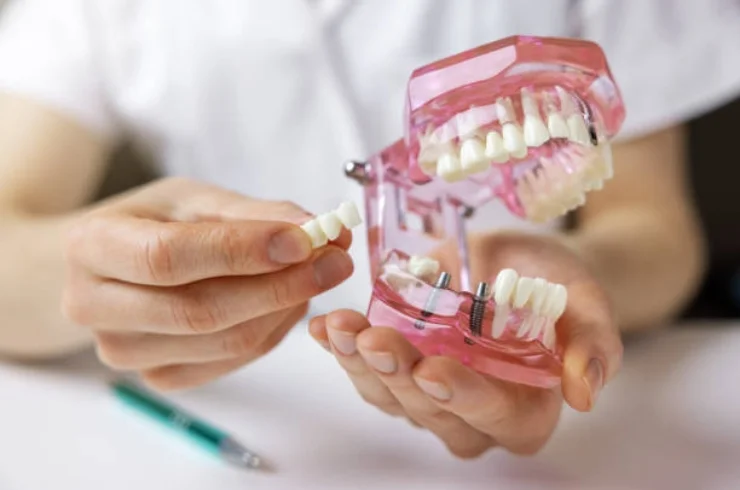Dental Implants

Dental implants are a revolutionary solution for replacing missing teeth, offering a strong, stable, and natural-looking alternative to traditional dentures or bridges. They are designed to function much like your natural teeth, providing both aesthetic and functional benefits.
What is a Dental Implant?
At its core, a dental implant is a small, screw-shaped post, typically made of biocompatible materials like titanium. This post is surgically placed into your jawbone, acting as an artificial tooth root. Over time, the jawbone integrates with the implant through a process called “osseointegration,” creating a solid foundation for a replacement tooth
Dental implants are a revolutionary solution for replacing missing teeth, offering a strong, stable, and natural-looking alternative to traditional dentures or bridges. They are designed to function much like your natural teeth, providing both aesthetic and functional benefits.
What is a Dental Implant?
At its core, a dental implant is a small, screw-shaped post, typically made of biocompatible materials like titanium. This post is surgically placed into your jawbone, acting as an artificial tooth root. Over time, the jawbone integrates with the implant through a process called “osseointegration,” creating a solid foundation for a replacement tooth.
A complete dental implant typically consists of three main components:
- The Implant Post: This is the screw-like fixture embedded in the jawbone.
- The Abutment: A small connector piece that attaches to the top of the implant post and extends slightly above the gum line. It serves as the base for the prosthetic tooth.
- The Restoration (Crown, Bridge, or Denture): This is the visible part of the tooth replacement, custom-made to match your natural teeth in color, shape, and size. It can be a single crown, a bridge (to replace multiple teeth), or even support a full denture.
The Dental Implant Procedure
The process of getting a dental implant usually involves several stages and can take several months, allowing for proper healing and integration.
- Initial Consultation and Planning: The journey begins with a comprehensive dental examination, including X-rays or CT scans, to assess your oral health, jawbone density, and the ideal placement for the implant. Your dentist or oral surgeon will develop a personalized treatment plan.
- Tooth Extraction (if needed): If the damaged or decayed tooth is still present, it will be extracted.
- Bone Grafting (if needed): If your jawbone isn’t dense enough to support the implant, a bone graft may be necessary to rebuild the bone. This adds to the overall treatment time as the graft needs to heal.
- Implant Placement Surgery: During this surgical procedure, the gum is opened to expose the jawbone, and a small hole is drilled to precisely insert the titanium implant post. The gum tissue is then typically closed over the implant.
- Osseointegration (Healing Period): This is a crucial phase where the implant fuses with the jawbone. This process can take several months (typically 3-6 months for the lower jaw and up to 7 months for the upper jaw).
- Abutment Placement: Once osseointegration is complete, a minor procedure may be performed to expose the implant and attach the abutment. In some cases, the abutment can be placed during the initial implant surgery.
- Restoration Placement: After the gums heal around the abutment, impressions of your mouth are taken to custom-fabricate your permanent crown, bridge, or denture. Once ready, this restoration is securely attached to the abutment.
Benefits of Dental Implants
Dental implants offer numerous advantages over other tooth replacement options:
- Natural Look and Feel: They closely resemble natural teeth in appearance and function.
- Improved Chewing and Speech: Implants provide stable support, allowing you to eat and speak with confidence.
- Bone Preservation: Unlike bridges or dentures, implants stimulate the jawbone, preventing bone loss that typically occurs after tooth loss. This helps maintain facial structure.
- Longevity: With proper care and oral hygiene, dental implants can last for decades, often a lifetime, while the crowns attached to them may need replacement after 10-15 years due to normal wear and tear.
- No Impact on Adjacent Teeth: Unlike bridges, implants do not require altering or grinding down healthy adjacent teeth.
- Enhanced Self-Esteem: A complete and confident smile can significantly boost your self-confidence.